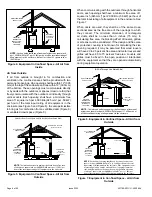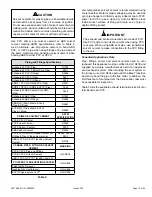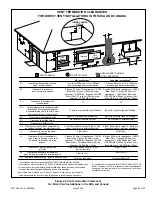
507769-05G / 31-5000656
Page 14 of 55
Issue 2223
Capacity
Vent Pipe Dia.
(in.)
Standard
Concentric
Flush Mount Kit
Field
Fabricated
1-1/2 inch
2 inch
3 inch
51W11 (US) 51W12
(CA)
71M80 (US)
4
44W92 (CA)
69M29 (US)
4
44W92 (CA)
60L46 (US)
4
444W93 (CA)
045
1
1-1/2
3
YES
5
YES
2
YES
N/A
N/A
2
3
YES
5
YES
2
YES
2-1/2
3
YES
5
YES
2
YES
3
3
YES
5
YES
2
YES
070
1
1-1/2
3YES
5
YES
2
YES
2
3YES
5
YES
2
YES
2-1/2
3
YES
5
YES
2
YES
3
3
YES
5
YES
2
YES
090
2
3
YES
5
YES
N/A
YES
YES
2-1/2
3
YES
5
YES
YES
YES
3
3
YES
5
YES
YES
YES
NOTE - Standard Terminations do not include any vent pipe or elbows external to the structure. Any vent pipe or elbows external to the structure must be included in total
vent length calculations. See vent length tables.* Kits must be properly installed according to kit instructions.
1Requires field-provided outdoor 1-1/2” exhaust accelerator.
2Concentric kits 71M80 and 44W92 include 1-1/2” outdoor accelerator, when used with 045 and 070 input models. When using 1-1/2 in. piping, the pipe must transition to
2in. pipe when used with the concentrci kit.
3 Flush mount kits 51W11 and 51W12 includes 1-1/2 in. outdoor exhaust accelerator, required when used with 045, 070 and 090 input models. When using 1-1/2 in. piping,
the pipe must transition to 2in. pipe when used with the flush mount kit.
4 Termination kits 44W92 and 44W93 are certified to ULC S636 for use in Canada only.
5 See table 10 for vent accelerator requirements
6 2inch to 1-1/2 inch reducer required. must be fied required.
Table 5. Outdoor Termination Kits Usage
Joint Cementing Procedure
All cementing of joints should be done according to the
specifications outlined in ASTM D 2855.
NOTE:
A sheet metal screw may be used to secure the
intake pipe to the connector, if desired. Use a drill or self
tapping screw to make a pilot hole.
DANGER OF EXPLOSION!
Fumes from PVC glue may ignite during system check.
Allow fumes to dissipate for at least 5 minutes before
placing unit into operation.
DANGER
1. Measure and cut vent pipe to desired length.
2. Debur and chamfer end of pipe, removing any ridges
or rough edges. If end is not chamfered, edge of pipe
may remove cement from fitting socket and result in a
leaking joint.
3. Clean and dry surfaces to be joined.
4.
Test fit joint and mark depth of fitting on outside of pipe.
5. Uniformly apply a liberal coat of PVC primer for PVC
or use a clean dry cloth for ABS to clean inside socket
surface of fitting and male end of pipe to depth of fitting
socket.
6. Promptly apply solvent cement to end of pipe and
inside socket surface of fitting. Cement should be
applied lightly but uniformly to inside of socket. Take
care to keep excess cement out of socket. Apply
second coat to end of pipe.
NOTE:
Time is critical at this stage. Do Not allow
Primer to dry before applying cement.
7. Immediately after applying last coat of cement to pipe,
and while both inside socket surface and end of pipe
are wet with cement, forcefully insert end of pipe into
socket until it bottoms out. Turn PVC pipe 1/4 turn
during assembly (but not after pipe is fully inserted) to
distribute cement evenly. Do not turn ABS or cellular
core pipe.















































